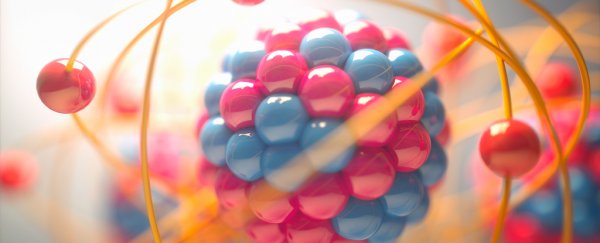If you're feeling as if you've lost a bit of weight recently, blame physicists – recent calculations make the mass of the proton 30 billionths of a percent lighter than before.
Okay, so the sub-atomic particle hasn't changed size, but new experiments have promoted a rethink on what the proton probably weighs. Strangely, while the new figure is three times more accurate than the previous one, nobody is sure why the new number is different.
Experiments conducted by the Max Planck Institute for Nuclear Physics in Germany used magnetic fields to trap a proton inside a vacuum chilled to near absolute zero, where they watched it wander around.
By determining the particle's velocity they could calculate its mass as compared to the nucleus of carbon 12 and a particle of hydrogen at a set frequency.
For those interested, a proton now happens to be 1.007 276 466 583 atomic units, slightly different to the mass of 1.007 276 466 879 atomic units the Committee on Data for Science and Technology (CODATA) currently has recorded.
The difference might not seem like a big deal, but there is no clear reason for it.
"Of course, 99 percent of the time, it's an experimental issue," CODATA member Peter Mohr told New Scientist's Sophia Chen.
The research has been put onto the pre-review website arXiv.org, where the physics community can take a close look at their figures.
With an accuracy of 32 parts per trillion, the tweak is an improvement on the last number by a factor of three. The researchers now plan on implementing some changes to the experiments to try to improve on their precision.
You won't need to go fiddling with your bathroom scales, but CODATA will be required judge what to make of the difference in light of potential changes to its recommended values.
Similar to the Planck constant (which also changed recently) and the speed of light, the mass of the proton is a fundamental unit in physics.
It's used to determine a limiting value in spectroscopy called the Rydberg constant.
It could also help physicists answer a rather trivial question: "Why is there stuff instead or no stuff?"
Clearly stuff exists, but since matter and anti-matter have an annoying habit of cancelling each other out in a burst of radiation, there must be a fundamental difference in how much matter and antimatter formed early in the Universe's formation for the particles making up cows and comets to exist at all.
Things like charge, parity (space), and time have a fundamental symmetry summed up in what's called the CPT theorem.
In simple terms, if we can find a problem with this theorem – and finding a difference in the masses of protons and their anti-particle would definitely count as a big problem – then we might have some insight into why one form of matter dominated over the other.
That would require a similar, highly precise experiment to be done with antiprotons, with any differences in experimental data being ruled out.
Last year, CERN came up with a new figure for antiproton masses that was in good agreement with previous proton mass measurements, leaving no room for CPT variation.
There's a slim chance future experiments might detect a tiny difference, but it's unlikely that this change in proton mass is a sign of anything amazing. "We don't break through new principles that often," says Mohr.
According to Hamish Johnston at physicsworld.com, greater precision in the proton's mass could help explain why the particle's radius appears in experiments to be 4 percent smaller than theory predicts.
Meanwhile, we predict the proton diet will be the next big thing; lose 30 billionths of a percent without even trying. Watch this space.
